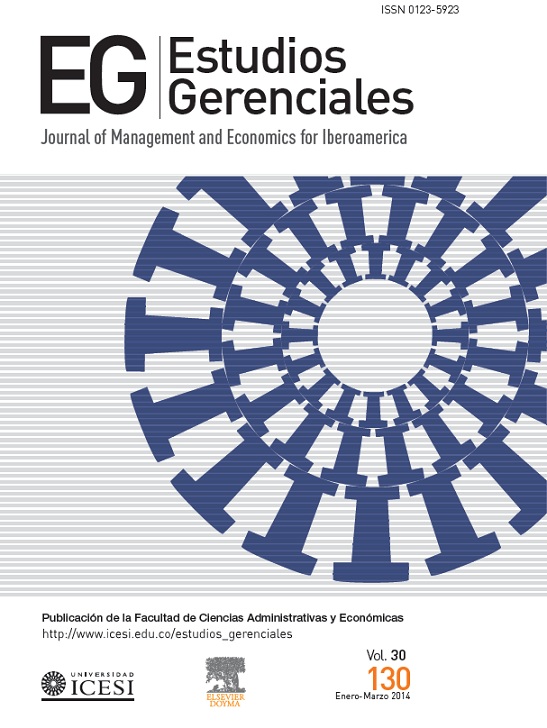Evaluando las intervenciones cambiarias en Colombia: 2004-2012
DOI:
https://doi.org/10.1016/j.estger.2014.02.009Palavras-chave:
Intervenciones cambiarias, Modelo de canal de coordinación, Red neuronal de regresión del cuantilResumo
Esta investigación tiene como propósito evaluar la efectividad de las intervenciones en el mercado cambiariocolombiano, utilizando el modelo teórico canal de coordinación bajo la metodología red neuronal
de regresión cuantil. Con este objetivo se estima el efecto de los inversionistas no informados, informados
y el emisor en diferentes cuantiles de la distribución del retorno de la tasa de cambio en el largo
plazo. Se encuentra que la autoridad cambiaria tiene una mayor influencia en los cuantiles inferiores de
la distribución, como son los de 5 y 25%, que recogen efectos asociados con la revaluación del peso.
Downloads
Referências
Beine, M. (2004). Conditional covariances and direct central bank intervention in the foreign exchange markets. Journal of Banking & Finance, 28(6), 1385–1411.
Cannon, A. J. (2011). Quantile regression neural network: Implementation in R and application to precipitation downscaling. Computers and Geosciences, 37(9), 1277–1284.
Clements, M. P. y Taylor, N. (2003). Evaluating interval forecasts of high-frequency financial data. Journal of Applied Econometrics, 18(4), 445–456.
Cristoffersen, P. F. (1998). Evaluating interval forecasts. International Economic Review, 39(4), 841–862.
Cushman, D. O. (2007). A portfolio balance approach to the Canadian-U.S. exchange rate. Review of Financial Economics, 16(3), 305–320.
Dominguez, K. M. (1998). Central bank intervention and exchange rate volatility. Journal of International Money and Finance, 17(1), 161–190.
Dominguez, K. M. (2003). The market microstructure of central bank intervention. Journal of International Economics, 59(1), 25–45.
Dominguez, K. M. (2006). When do central bank interventions influence intra-day and longer-term exchange rate movements?. Journal of International Money and Finance, 25(7), 1051–1071.
Dominguez, K. M. y Frankel, J. (1993). Does foreign-exchange intervention matter? The portfolio effect. The American Economic Review, 83(5), 1356–1369.
Echavarría, J., Vásquez, D. y Villamizar, M. (2010). Impacto de las intervenciones cambiarias sobre el nivel y la volatilidad de la tasa de cambio en Colombia. Ensayos sobre Política Económica, 28(62), 12–69.
Engle, R. F. y Manganelli, S. (2004). CAViaR: Conditional autoregressive value at risk by regression quantiles. Journal of Business & Economic Statistics, 22(4), 367–381.
Fatum, R. y Hutchison, M. M. (2003). Is sterilized foreign exchange intervention effective after all? An event study approach. The Economic Journal, 113(487), 390–411.
Franses, H. P. y Dijk, D. (1999). Nonlinear Time Series Models in Empirical Finance. London: Cambrige University Press.
Humpage, O. F. (2000). The United States as an informed foreign-exchange speculator. Journal of International Financial Markets. Institutions and Money, 10(3-4), 287–302.
Kamil, H. (2008). Is central bank intervention effective under inflation targeting regimes? The case of Colombia. IMF Working Paper, 88, 1–44.
Koop, G., Pesaran, M. H. y Potter, S. M. (1996). Impulse response analysis in nonlinear multivariate models. Journal of Econometrics, 74(1), 119–147.
Lewis, K. (1995). Are foreign exchange intervention and monetary policy related, and does it really matter?. Journal of Business, 68(2), 185–214.
Londoño, C. A. (2011). Regresión del cuantil aplicada al modelo de redes neuronales artificiales. Un ejercicio empírico del modelo CAViaR para el mercado de valores colombiano. Revista Ensayos sobre Política Económica, 29(64), 62–109.
Payne, R. y Vitale, P. (2003). A transaction level study of the effects of central bank intervention on exchange rates. Journal of International Economics, 61(2), 331–352.
Pasquariello, P. (2007). Informative trading or just costly noise? An analysis of central bank interventions. Journal of Financial Markets, 10(2), 107–143.
Pavasuthipaisit, R. (2010). Should inflation-targeting central bank respond to exchange rate movements?. Journal of International Money and Finance, 29(3), 460–485.
Peiers, B. (1997). Informed traders, intervention, and price leadership: A deeper view of the microstructure of the foreign exchange market. The Journal of Finance, 52(4), 1589–1614.
Sarno, L. y Taylor, M. (2001). Official intervention in the foreign exchange market: Is it effective and, if so, how does it work?. Journal of Economic Literature, 39(3), 839–868.
Reitz, S. y Taylor, M. P. (2008). The coordination channel of foreign exchange intervention: A nonlinear microstructural analysis. European Economic Review, 52(1), 55–76.
Reitz, S., Rulke, J. C. y Taylor, M. (2011). On the nonlinear influence of Reserve Bank of Australia interventions on exchange rates. The Economic Record, 87(278), 465–479.
Taylor, J. W. (2000). A quantile neural network approach to estimating the conditional density of multiperiod return. Journal of Forescasting, 19(4), 299–311.
Downloads
Publicado
Edição
Seção
Licença
Os autores dos artigos serão responsáveis dos mesmos e, assim, não comprometam os princípios ou políticas da Universidade Icesi nem do Conselho Editorial da revista Estudios Gerenciales. Os autores autorizam e aceitam a transferência de todos os direitos para a revista Estudios Gerenciales para a publicão impressa ou eletrônica. Após a publicação do artigo, pode ser reproduzido sem a permissão do autor ou da revista, se mencionar o(s) autor(es), o ano, o título, o volume e o número e o intervalo de páginas da publicação, e Estudios Gerenciales como fonte (se abster de utilizar Revista Estudios Gerenciales).








